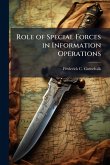Deception has been a part of warfare throughout history and has proven a very effective force multiplier when employed correctly. Many esteemed military theorists have espoused the merits of deception including; Sun Tzu, Carl von Clausewitz, Mao Tse Tung, and Basil Liddell Hart. The challenge, however, in incorporating military deception is that it can be very difficult to plan, coordinate, and synchronize from the strategic through the operational and tactical levels of war. The increased demand for intelligence, information superiority, as well as the increased need for operational security to conduct successful deception also present a significant challenge to military planners. Additionally, deception requires a great deal of creativity and unconventional thinking on the part of the deceiver and is considered more art than science which makes it difficult to train within the military. Although the U.S. conventional military practiced deception at all levels of war on a number of occasions during World War II, it has since significantly reduced its use of deception above the tactical level, opting instead, to rely on its superior firepower, maneuver, and technology. However, while the conventional military has decreased its use of deception over the last sixty years, another force within the U.S. military, Special Operations Forces (SOF) has included the art of deception in their operations throughout their history. These highly trained soldiers depend on deception as a force multiplier and provide the U.S. military a unique tool with which to employ deception in support of large-scale conventional operations. This monograph examines the art of deception and analyzes the potential use of employing U.S. Special Operations Forces to conduct deception in support of conventional shaping and decisive operations. The study begins with an introduction to deception and discusses why, in the aggregate, deception operations have declined for the U.S. over the last six dec This work has been selected by scholars as being culturally important, and is part of the knowledge base of civilization as we know it. This work was reproduced from the original artifact, and remains as true to the original work as possible. Therefore, you will see the original copyright references, library stamps (as most of these works have been housed in our most important libraries around the world), and other notations in the work. This work is in the public domain in the United States of America, and possibly other nations. Within the United States, you may freely copy and distribute this work, as no entity (individual or corporate) has a copyright on the body of the work. As a reproduction of a historical artifact, this work may contain missing or blurred pages, poor pictures, errant marks, etc. Scholars believe, and we concur, that this work is important enough to be preserved, reproduced, and made generally available to the public. We appreciate your support of the preservation process, and thank you for being an important part of keeping this knowledge alive and relevant.
Bitte wählen Sie Ihr Anliegen aus.
Rechnungen
Retourenschein anfordern
Bestellstatus
Storno








